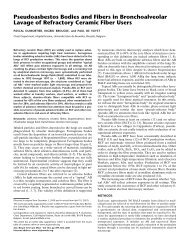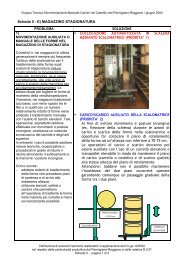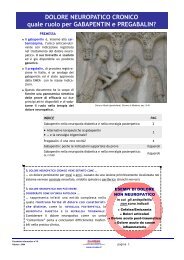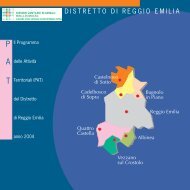Download PDF
Download PDF
Download PDF
- No tags were found...
You also want an ePaper? Increase the reach of your titles
YUMPU automatically turns print PDFs into web optimized ePapers that Google loves.
Arch Womens Ment Health (2009) 12:3–13DOI 10.1007/s00737-008-0039-0REVIEW ARTICLEA systematic review of home-based interventions to preventand treat postpartum depressionJulie A. Leis & Tamar Mendelson & S. Darius Tandon &Deborah F. PerryReceived: 24 August 2008 /Accepted: 1 December 2008 / Published online: 10 January 2009# Springer-Verlag 2008Abstract This systematic review evaluated randomizedcontrolled trials assessing home-based psychological interventionsto prevent and treat postpartum depression (PPD).Six studies meeting inclusion criteria were identified, fiveassessing treatments for PPD and one assessing a preventiveintervention for PPD. Interventions used cognitivebehavioral, psychodynamic, and non-directive counselingapproaches. Of the six studies reviewed, four reportedstatistically significant treatment effects on PPD followingthe intervention. Each of the three types of psychologicalinterventions were shown to reduce levels of maternaldepression. Recommendations for future development andevaluation of home-based psychological interventions forPPD are discussed. These include identification of mediatorsand moderators of intervention efficacy, exploringstrategies for prevention of PPD, and targeting high-riskgroups.J. A. Leis (*)Department of Mental Health,Johns Hopkins Bloomberg School of Public Health,624 N. Broadway, P.O. Box 502, Baltimore, MD 21205, USAe-mail: jleis@jhsph.eduT. MendelsonDepartment of Mental Health,Johns Hopkins Bloomberg School of Public Health,Baltimore, MD 21205, USAS. D. TandonDepartment of Pediatrics,Johns Hopkins University School of Medicine,Baltimore, MD, USAD. F. PerryDepartment of Population, Family, and Reproductive Health,Johns Hopkins Bloomberg School of Public Health,Baltimore, MD, USAKeywords Postpartum depression . Review . Home-based .Home visiting . InterventionsPostpartum depression (PPD) affects approximately 10 to15% of new mothers after childbirth (Gaynes et al. 2005;O’Hara and Swain 1996), and the average prevalence rateof non-psychotic postpartum depression symptomatologyhas been estimated at 13% (O’Hara and Swain 1996). Likeepisodes of depression at other points in the lifespan,depression during the postnatal period has negative consequencesboth for women and their families. Data indicatethat women experiencing postpartum depression are lesslikely than non-depressed women to breastfeed, play andtalk with their newborns, or comply with immunizationsand well-child visits (McLearn et al. 2006; Chung et al.2004; Mandl et al. 1999; Minkovitz et al. 2005). Childrenof women with PPD are at risk for poor developmentaloutcomes, including emotion regulation problems, socialinteraction difficulties, and attachment insecurity (Cogillet al. 2005; Grace et al. 2003; Hipwell et al. 2000; Murrayet al. 1999; Sohr-Preston and Scaramella 2006), in part dueto poor maternal parenting practices (Goodman and Gotlib,1999). The high prevalence of PPD and its negative impacton women and children constitute a significant publichealth problem.Home-based interventions during the perinatal period(defined as pregnancy through the child’s firstbirthday)have increased in variety and scope in recent years (e.g.,Olds et al. 2000). While home-based intervention modelsand goals vary, all home-based interventions deliverservices in clients’ homes rather than expecting familiesto seek out services. Home visiting—one type of homebasedintervention—involves regular home visits topregnant women or new mothers by health or mentalhealth professionals or paraprofessionals and may be
4 J.A. Leis et al.guided by different models or approaches. Such visits maytarget birth or infant outcomes, as well as maternal health,mental health, or parenting skills. Recent reviews of homevisiting programs have found that they have a modest impactin promoting positive parenting behavior and reducing childabuse and neglect (Sweet and Appelbaum 2004). There isrelatively little research regarding the impact of home-basedinterventions, including home visiting, on the prevention andtreatment of PPD.Home-based interventions have considerable potential toaddress PPD effectively for several reasons. First, fewpeople who experience depression seek treatment (Fortneyet al. 1998; U.S. Department of Health and Human Services2001). The Surgeon General’s report on Mental Healthcited treatment-seeking rates as low as 25% in people withdiagnosed disorders (U.S. Department of Health andHuman Services 2001) and rates for low-income, minoritypopulations may be even lower (Miranda et al. 1998).Research suggests that although pregnant women mayinteract with the health care system more than at any othertime in their lives, detection and treatment of depressionremains a problem (Kelly et al. 2001; Lumley et al. 2004;U.S. Department of Health and Human Services 2001).Home-based interventions for women who have recentlydelivered have the potential to introduce mental healthservices to women who do not tend to seek out such services.Second, home-based interventions, particularly homevisiting, typically serve high-risk, low-income familieswho may have the greatest need for mental healthservices yet face significant barriers to obtaining mentalhealth care. The few studies that have examinedprevalence of depression in low-income women showhigher levels of depression among these women comparedto women with greater financial resources (Bennettet al. 2004; Hobfolletal.1995; Holzman et al. 2006).Studies among women of low socio-economic status(SES) have reported depression symptom prevalenceranging from 29 to 51% (Administration for Childrenand Families 2006; McKee et al. 2001; Boltonetal.1998;Da Silva et al. 1998; Seguinetal.1995) and one study oflow SES women found that 16% experienced a majordepressive episode in their second trimester (Hobfoll et al.1995), a prevalence nearly double the pooled prevalencerate for middle-class samples reported by Bennett et al.(2004). This doubling of risk for depression for lowincome,minority perinatal womenwasmirroredinstudiesof women drawn from Women, Infant, and Children(WIC) clinics (Cordero and Kurz 2006; Kurz2005; Kurzand Hesselbrock 2006).Third, home-based programs are a natural place tointegrate the prevention and/or treatment of PPD becausesuch programs already serve large numbers of pregnant andrecently delivered women. Recent years have seen aproliferation in the number of home visiting programs withthis trend likely to continue. There are home visitingprograms in all states; some states have taken specificmodels to scale (e.g., Nurse-Family Partnership, Parents asTeachers, Healthy Families America, Healthy Start), withprograms in nearly every community statewide. Congressrecently considered legislation to expand and improvehome-based parenting services through the EducationBegins at Home Act (U.S. Department of Health & HumanServices 2008).Existing interventions for PPD occurring in the homehave taken one of two approaches: prevention or treatment.Preventive interventions are designed to reduce the developmentof a mental disorder and therefore are implementedbefore the onset of a disorder (Mrazek and Haggery 1994).Within the prevention paradigm, interventions are furtherclassified into three levels which are defined by thepopulations they target: universal, selective, and indicated.Universal preventive interventions target the general populationor a whole population group without regard toindividual risk for a mental disorder, selective preventiveinterventions target individuals or a subgroup of the populationwho have risk factors which increase the likelihoodof developing a mental disorder, and indicated preventiveinterventions target individuals at high risk for developinga mental disorder who have detectable signs or symptoms ofa mental disorder but do not currently meet criteria for adisorder (Mrazek and Haggery 1994). Treatment interventions,on the other hand, target individuals who already meetcriteria for a mental disorder and focus on decreasing theseverity and/or duration of a mental disorder and reducingrisk for future episodes of the disorder.This manuscript reviews what is known about homebasedinterventions’ impact on the prevention andtreatment of PPD. Although three reviews of interventionsto prevent and treat PPD have been published(Dennis and Creedy 2004; Dennis and Hodnett 2007;Lumley et al. 2004), those reviews do not focus specificallyon the impact of home-based interventions on PPD.Given the potential of home-based interventions toaddress PPD and increasing use of home-based interventionsduring the perinatal period, this review provides thefirst in-depth examination of home-based interventions’impact on preventing and treating PPD. We focus ourreview on psychological interventions given researchsuggesting that many mothers prefer non-pharmacologicalinterventions (Dennis and Chung-Lee 2006) and ourbelief that these interventions may have the greatestpotential to impact PPD. Psychological interventionsrefer to an array of structured approaches that incorporatepsychological methods (e.g., cognitive-behavioral therapy,interpersonal psychotherapy) to reduce psychologicaldistress or promote adaptive functioning.
Home-based interventions for postpartum depression 5MethodsPubMed, PsycInfo, Embase, and CINAHL databases weresearched from their inception to February 2008 usingcombinations of the terms home-based, home visiting,home visitation, home visit, depression, postpartum depression,postnatal depression, perinatal depression, prevention,treatment, intervention. The search was limited topeer-reviewed studies published in English. In addition,studies referenced in relevant published articles and reviews(Dennis and Creedy 2004; Dennis and Hodnett 2007;Lumley et al. 2004) were assessed.To be selected for inclusion, a study was required tomeet the following criteria: (1) assessment of a home-basedpsychological intervention in which prevention or treatmentof PPD was a primary or secondary goal, (2) study sampleof pregnant women or women with a child < 1 year old, (3)randomized controlled trial design, and (4) publication in apeer-reviewed journal. Literature reviews, meta-analyses,and case studies were excluded.Our initial search yielded 24 abstracts that appeared tomeet the specified inclusion criteria; those articles wereobtained and reviewed. Upon closer review of those 24studies, seven were excluded because they reported on nonpsychologicalinterventions (Armstrong et al. 1999;Armstrong et al. 2000; Fraser et al. 2000; Gelfand et al.1996; Morrell et al. 2000; Navaie-Waliser et al. 2000;Roman et al. 2007), one was excluded because the samplewas not restricted to mothers of children less than 1 yearold (Beeber et al. 2004), one was excluded because therewas no comparison group (Ammerman et al. 2005), twowere excluded because assignment to intervention orcontrol was not randomized (Austin et al. 1999; Cullinan1991), two were excluded because they combined resultsfor home-based and clinic-based services (Wickberg andHwang 1996; Zayas et al. 2004), and another four studieswere excluded because there was not enough informationgiven to determine the specific type of interventionemployed (Koniak-Griffin et al. 2002; Marcenko andSpence 1994; Marcenko et al. 1996; Tezel and Gözüm2006). An overview and critique of the six articles meetingcriteria for inclusion in the review are presented below.ResultsTable 1 displays the location, dates, intervention approach(i.e., prevention or treatment), sample description, interventiondesign, intervention provider, and control condition(s)for each of the six articles reviewed. Only one study reportedon a home-based intervention to prevent PPD (Wiggins etal. 2005); the remaining five studies described home-basedinterventions to treat PPD (Appleby et al. 1997; Chabrol etal. 2002; Cooper et al. 2003; Holden et al. 1989;Prendergast and Austin 2001). Most studies recruitedcommunity-based samples, with only one trial recruiting asample of women determined to be at high risk fordepression as a function of neighborhood socioeconomicdeprivation (Wiggins et al. 2005). Intervention lengthranged from 5 weeks to 1 year with most lasting 6 to8 weeks. Three studies used health visitors as interventionists(Appleby et al. 1997; Holden et al. 1989; Wiggins et al.2005), one used nurses to deliver the intervention(Prendergast and Austin 2001), one used masters-leveltherapists (Chabrol et al. 2002), and one used a combinationof mental health clinicians and health visitors (Cooperet al. 2003).Two studies employed non-directive counseling, alsocommonly referred to as “listening visits”, as theirintervention (Holden et al. 1989; Wiggins et al. 2005).Non-directive counseling is based on principles of Rogeriantherapy and the assumption that talking to a supportiveprofessional “will help people take a more positive view ofthemselves and their lives” (Holden et al. 1989, p. 224).The role of the counselor in non-directive counseling is toaid in exploration and understanding of feelings but not tooffer judgment or advice (Dennis and Hodnett 2007). Threestudies assessed interventions that used cognitive behavioraltherapy (CBT) techniques (Appleby et al. 1997; Chabrolet al. 2002; Prendergast and Austin 2001). CBT techniquesinclude modification of negative and dysfunctionalthoughts, as well as strategies to increase pleasant activitiesand decrease behaviors leading to low mood (Beck et al.1979; Lewinsohn et al. 1986). One study compared nondirectivecounseling to CBT and psychodynamic therapy(Cooper et al. 2003). Psychodynamic therapy is a broadbasedcategory that includes diverse treatments and explanatorymodels derived from Freudian and post-Freudiantheories (Gibbons et al. 2008). Psychodynamic approachesgenerally emphasize exploration of early experiences andattachments to provide insight into current functioning.Study findings are described below. Table 2 presents asummary of study results, as well as depression measuresused and analyses conducted (e.g., intention-to-treat).Non-directive counseling studiesOne of the two non-directive counseling interventions wasreported to be effective in preventing or treating PPD. Thefirst trial of non-directive counseling was conducted byHolden and colleagues in 1989. Women who scored > 12on the Edinburgh Postnatal Depression Scale (EPDS; Coxet al. 1987) 6 weeks after delivery, and met researchdiagnostic criteria for minor or major depression 12 weeksafter delivery on Goldberg’s Standardized PsychiatricInterview (Goldberg et al. 1970), were randomized to
6 J.A. Leis et al.Table 1 Characteristics of included studiesStudy Location/dates Study type N Sample description Intervention condition Intervention provider Control conditionApplebyet al. 1997Chabrolet al. 2002Cooper et al.2003Holden et al.1989Prendergast andAustin, 2001Wiggins et al.2005South Manchester,EnglandMay 1993–Feb 1995Toulouse and Narbonne, FranceDec 1999–Mar 2000Cambridge, EnglandJan 1990–Aug 1992Edinburgh and Livingston,ScotlandNREastern Sydney, AustraliaNRLondon, EnglandMar 1999–Nov 2000Treatment 87 Urban,community sampleTreatment 48 Community sample 5–8 weekly CBT sessionsincorporating elements of supportive,educational, and psychodynamic therapiesTreatment 193 Community sample 10 weekly sessions of either CBT,psychodynamic therapy,or non-directive counselingTreatment 55 Community sample 8 weekly sessionsof non-directive counselingPlacebo + 6 biweekly CBT sessions Psychologist 3 control groups:C1: Fluoxetine+1CBT sessionC2: Fluoxetine+6 CBT sessionsC3: Placebo+1CBT sessionMaster’s Degreelevel therapistsSpecialists in each of thethree treatments or nonspecialisthealth visitorsRoutine careRoutine careHealth visitors Routine careTreatment 37 Community sample 6 weekly CBT sessions Early Childhood Nurses 6 weekly supportsessionsPrevention 731 Urban, high-risk,community sample1 year of monthlynon-directive counseling sessionsHealth visitors Routine careNR not reported
Home-based interventions for postpartum depression 7Table 2 Depression measures, type of analysis, and results of included studiesStudy Depression measures Intention-totreatanalysisResultsAppleby et al.1997Chabrol et al.2002Cooper et al.2003Holden et al.1989Prendergast andAustin, 2001Wiggins et al.2005EPDS Yes Immediately post-intervention, all 4 groups showed significant improvementHAM-Don the Revised Clinical Interview ScheduleRevised Clinical InterviewSchedule6 sessions of CBT were more effective than 1 session on the Revised ClinicalInterview Schedule and HAM-D but not on the EPDSBDI Yes a Immediately post-intervention, women in the intervention group had reducedEPDSscores on all measures compared to women in the control groupHAM-DThere was a 60% difference in recovery rate between the intervention andcontrol groups favoring the interventionEPDS Yes Immediately post-intervention, women in all 3 intervention groups had lowerEPDS scores compared to women in the control group and women in thepsychodynamic therapy group had lower rates of depression compared towomen in the control groupAt 9, 18, and 60 months postpartum, none of the intervention groups differedsignificantly from the control group on either measureEPDS No Immediately post-intervention, women in the intervention group had aStructured Clinicalsignificant reduction in mean scores from baseline on both measuresInterview for DSM-III-Rcompared to women in the control groupThere was a 32% difference in recovery rate between the groups favoringinterventionEPDS No There were no significant differences between the groups on any of theGoldberg’s Standardizedmeasures immediately or 6-months post-interventionPsychiatric InterviewMADRSEPDS Yes There were no significant differences between the intervention and controlGHQgroups immediately or 6-months post-interventionBDI Beck Depression Inventory; EPDS Edinburgh Postnatal Depression Scale; GHQ General Health Questionnaire; HAM-D HamiltonDepression Rating Scale; MADRS Montgomery-Asberg Depression Rating Scalea All subjects in both groups completed the treatment protocol and were re-assessed post-interventionintervention or routine care. Women in the interventiongroup received an average of 8.8 sessions of non-directivecounseling for at least 30 min delivered by a health visitortrained in the methods of this psychological intervention.Immediately post-intervention, results indicated that 69% ofwomen in the intervention group and 38% of women in thecontrol group had recovered from depression. In addition,women who received the intervention had a significantreduction in mean scores on the EPDS and Goldberg’sStandardized Psychiatric Interview compared to womenreceiving routine care. However, some participants weretaking antidepressants during the study period, and antidepressantuse was not controlled in analyses, possiblyleading to bias in these results. In addition, the authorsdid not conduct intention-to-treat analyses.Findings from a larger trial of non-directive counselingconducted by Wiggins et al. (2005) differed from thosereported by Holden et al (1989). In this selective preventiveintervention, women living in deprived areas of Londonwere randomized to routine care or an interventioncondition consisting of monthly home-based non-directivecounseling sessions delivered by health visitors. Over the12-month duration of the study, women in the non-directivecounseling intervention group received an average of 10 hof support in seven home visits and additional contacts overthe phone. Immediately post-intervention, there were nodifferences in depressive symptoms, as assessed by theEPDS, between women randomized to the home-basednon-directive counseling intervention and women randomizedto routine care. The same results were found sixmonthspost-intervention when depressive symptoms weremeasured with the General Health Questionnaire (GHQ;Goldberg and Williams 1988). However, neither the use ofroutine health visiting services available to women in thecontrol condition nor baseline depressive symptoms orsociodemographic characteristics were accounted for in theanalyses, and different measures were used to assessdepressive symptoms immediately post-intervention and atthe 6 month follow-up.Overall, these two studies suggest that non-directivecounseling may be an effective treatment for PPD but maynot be as effective when used as a selective preventiveintervention. This pattern of findings may reflect design andmethodology differences between the Wiggins et al. (2005)study and the Holden et al. (1989) study beyond those dueto the different types of interventions employed. First,
8 J.A. Leis et al.Wiggins and colleagues recruited an urban, high-risksample, a population that may have required more intensiveintervention efforts than the sample recruited by Holden etal. (1989). Second, although prevention of PPD was onetarget of the Wiggins et al. intervention, it was not the solefocus of the intervention as it was in the other study. A thirdpotential reason for the lack of reduction in depressivesymptoms is that the protocol of Wiggins et al. involvedmonthly, rather than weekly, sessions of counseling.However, the results of these studies must also beconsidered in the context of some limitations. Holden etal. (1989) did not conduct intention-to-treat analyses orassess outcomes longitudinally and while Wiggins et al.(2005) did those two things, they did not use a manualizedintervention. Neither study took steps to monitor implementation.Cognitive behavioral therapy studiesThree studies assessed the use of home-based CBTinterventions for treatment of PPD (Appleby et al. 1997;Chabrol et al. 2002; Prendergast and Austin 2001). Allthree trials reported reductions in depression following theintervention, although only two found statistically significantbetween-group differences. The first study utilized afactorial design to investigate the use of CBT compared to apharmacological treatment. Appleby and colleagues (1997)randomized women who scored 10 or higher on the EPDS,12 or higher on the Revised Clinical Interview Schedule(Lewis et al. 1992), and met research diagnostic criteria formajor or minor depression to receive fluoxetine (Prozac) orplacebo in combination with either one 60 min session ofCBT or one 60 min session plus five biweekly 30 minsessions of CBT delivered by trained health visitors.Immediately post-intervention, women who received sixCBT sessions were less likely to meet criteria fordepression on the Revised Clinical Interview Scheduleand had lower scores on the Hamilton Depression RatingScale (HAM-D; Hamilton 1960), but not on the EPDS, thanwomen receiving one CBT session. Fluoxetine also provedeffective in lowering rates of depression and reducingdepressive symptoms but the combination of fluoxetine andCBT did not lead to additional improvement above theeffect of either intervention alone. This study excludedwomen with chronic or treatment resistant depression andreported a high attrition rate (30%), which should be kept inmind when interpreting its findings.Chabrol et al. (2002) reported that CBT was effective fortreatment of PPD. In this two-tier combined prevention/treatment trial, women with symptoms of depression duringthe first 5 days postpartum were randomized to routine careor a one-hour individual prevention session delivered in anobstetric clinic by a masters-level therapist. Women in bothgroups completed the EPDS 4 to 6 weeks postpartum;thoseintheinterventiongroupwhoscored11orhigherand met DSM-IV (American Psychiatric Association1994) criteria for major depressive episode were askedto participate in a program of between five and eighthome visits, those in the control group who met the sameinclusion criteria continued to receive routine care.Participants in the intervention group received an averageof six weekly, one-hour sessions of a cognitive behavioraltreatment program delivered by Master’s Degreelevel therapists in their homes. Significant differences wereseen between women randomized to the home-basedtreatment and women randomized to routine care immediatelypost-intervention on the EPDS and Beck DepressionInventory (BDI; Beck et al. 1988), and there was a 60%difference in recovery rate favoring the intervention group(66.6% in the intervention group versus 6.6% in thecontrol group) on the HAM-D. Limitations of this studyinclude non-independent outcome assessment, the smallsample size, and lack of follow-up.A third trial evaluated a CBT treatment for PPDdelivered by nurses (Prendergast and Austin 2001). Womenscoring 12 or higher on the EPDS who met DSM-IVcriteria for major or minor depression were randomized toreceive six weekly home-based CBT sessions or six weeklyclinic visits that incorporated parenting advice and nonspecificemotional support also delivered by nurses.Intervention dosage differed between groups; all womenin the intervention group received all six sessions ofCBT whereas only 45% of women in the control groupattended all six sessions. While a reduction in symptomson the EPDS and Montgomery-Asberg DepressionRating Scale (MADRS; Montgomery and Asberg 1979)was seen for both groups immediately post-intervention,no significant differences were found between the groups,suggesting that the support provided during in-clinicvisits was as effective as CBT in reducing symptoms ofdepression. Six months post-intervention, there was atrend toward CBT being more effective with scores on theEPDS continuing to decrease for women in the CBTcondition but not for women in the control condition, butthere was no statistically significant difference in scoresbetween the groups. This was a very small trial with only17 participants in the intervention group and 20 participantsin the control group, however, and may not havehad enough power to detect differences of small tomoderate magnitude between the groups. In addition,women in both groups were taking antidepressants orherbal remedies for depression and this was not taken intoaccount in the analyses. Finally, the authors did notconduct intention-to-treat analyses.Taken together, these three studies suggest that homebasedCBT interventions are effective in reducing symp-
Home-based interventions for postpartum depression 9toms of PPD and that a relatively short six-session courseof treatment may be sufficient to produce such reductions inPPD symptoms. It is unclear from these studies, however, ifthe effects of CBT are sustained over time. The one studyusing CBT that followed participants post-intervention(Prendergast and Austin 2001) found that symptoms ofdepression continued to decrease in the intervention groupbut not in the control group 6 months post-intervention, butthis finding did not reach statistical significance. The resultsfrom these three studies should be interpreted with somecaution as several methodological concerns exist. OnlyAppleby et al. (1997) used independent assessors toevaluate study outcomes and as previously mentioned, onlyPrendergast and Austin (2001) followed participants overtime. In addition, only Prendergast and Austin (2001) andChabrol et al. (2002) used manualized interventions andattempted to ensure adherence to the treatment protocols.Comparison of multiple home-based intervention strategiesCooper et al. (2003) assigned women with an EPDS scoreof 12 or more who met DSM-III-R criteria for majordepression 8 weeks after delivery to cognitive-behavioraltherapy, psychodynamic therapy, non-directive counseling,or routine care. Women received 10 weeks of therapy fromeither a specialist in each of the three interventionconditions or a health visitor trained in two of the threeintervention conditions. Post-intervention, women in eachintervention group had lower EPDS scores than women inthe control group and women in the psychodynamic groupalso had lower rates of major depressive disorder comparedto women in the control group, as measured by theStructured Clinical Interview for DSM-III-R (SCID; Spitzeret al. 1992). At follow-up 9 months, 18 months, and 5 yearspostpartum, scores on the EPDS did not differ betweenwomen in the intervention groups and women who hadreceived routine care, however. Moreover, there were nodifferences in the rate of major depressive disorder betweenany of the intervention groups and the control group at the9 month, 18 month, or 5 year follow-ups. Post-interventionand at follow-up 9 months postpartum, women treated bynon-specialists were found to have a greater reduction inEPDS scores than women treated by specialists. Oneimportant factor that needs to be considered when interpretingthese results is that although the primary goal of thestudy was to examine the long-term effect of the threepsychological interventions on maternal mood, the CBTand psychodynamic interventions were designed to focusmore on the mother–infant relationship than on thedepression itself. It is possible that if an emphasis had beenplaced on dealing with the depression, the reduction insymptoms seen immediately post-intervention would havebeen sustained over time.DiscussionOur review suggests that home-based psychological interventionsare a promising approach for addressing postpartumdepression. Of the six studies reviewed, four reportedstatistically significant improvement in PPD following theintervention (Appleby et al. 1997; Chabrol et al. 2002;Cooper et al. 2003; Holden et al. 1989). Moreover, wefound that CBT (Appleby et al. 1997; Chabrol et al. 2002),non-directive counseling (Holden et al. 1989), and psychodynamic(Cooper et al. 2003) interventions each demonstratedpositive effects. Given the substantial risk oflong-term negative outcomes from untreated depressionfor both mothers and their families and the large number ofhome-based interventions delivered during the perinatalperiod, it is striking that so few home-based interventionsspecifically target PPD as a primary outcome. Along withan overarching recommendation to increase the number ofhome-based intervention trials aimed at preventing andtreating PPD, there are four areas we believe are critical foradvancing research on home-based psychological interventionsthat address postpartum depression.Researchers should articulate their theory of change,postulating and measuring mediators and moderatorsof effectiveness as they design and test interventionapproaches Theories of change specify the pathways ormechanisms through which an intervention is expected toproduce effects. These hypothesized pathways are ofteninformed by the underlying theoretical approach employedby the research team. For example, a cognitive-behavioralframework views depression as the product of faultythoughts; therefore, during CBT, the client is encouragedto identify these dysfunctional thoughts and is helped todevelop alternative, more positive thoughts. Measuring thismore proximal outcome (i.e., changes in dysfunctionalthoughts), in addition to the distal outcome (i.e., depressivesymptoms) can help us assess fidelity as well as effectiveness.Specifying moderators, such as parity, will also helpus better understand which approaches may work better fordifferent subgroups of vulnerable mothers. The studies wereviewed did not frame their research in this way, nor didthey assess risk, vulnerability, and protective factors andtheir hypothesized relationship to postpartum depression.This omission may be due to the fact that small samplesizes limited the ability to detect moderating and mediatinginfluences on PPD. However, inclusion of such models infuture studies is needed to increase our understanding ofwhich intervention components are most useful and why.This is particularly important given growing consensus thatnumerous risk and protective factors within multipleecological systems influence the onset and chronicity ofdepression and differences in outcomes (Garber 2006).
10 J.A. Leis et al.Mediators and moderators related to delivering theintervention which may affect the outcome of the studyshould also be carefully considered. One of the studiesreviewed examined the association between type ofintervention provider and depressive symptoms and surprisingly,found that immediately post-intervention and at9 months postpartum, women who were treated by trainednon-specialist health visitors had a significantly greaterreduction in depressive symptoms than women who weretreated by specialists in the treatments employed (Cooperet al. 2003). These findings have important implicationsfor service delivery and while they need to be replicated,suggest that researchers should examine who can bestdeliver the intervention. In addition, the number of sessionslikely to be needed, how long after the interventionparticipants should be followed, and specifically withrespect to preventive interventions, when the interventionshould be delivered (i.e., during pregnancy, postpartum, oracross both periods), and what level of intervention is mostappropriate to meet the needs of the target populationshould be considered.Research should expand our knowledge base aboutthe effectiveness of empirically-supported interventionsto prevent PPD Only one study we reviewed focused onpreventing PPD (Wiggins et al. 2005), with no preventiveeffects found for the non-directive counseling interventionused by this study. Prevention of mental disorders hasgained increasing attention in recent years, given thatprevalence of common mental illnesses exceeds availabletreatment resources (Muñoz 2001). Moreover, the knownharmful effects of maternal depression on infant socialemotionaldevelopment—as well as on subsequent maternalmental health—make pregnant women and newmothers a critical target for prevention efforts (Mendelsonand Muñoz 2006). Interventions using CBT approaches toprevent PPD have shown promising results in two studiestargeting low-income Latinas in prenatal care settings(Muñoz et al. 2007; Le et al. under review). InterpersonalPsychotherapy (IPT) has also shown promising effects inpreventing PPD in a low-income sample when deliveredin a prenatal medical clinic (Zlotnick et al. 2006). Thesefindings suggest the need to explore whether CBT and IPTapproaches are effective in preventing PPD via homebasedinterventions.Additional research on PPD interventions should focuson high-risk groups, especially low-income, ethnic minoritiesPopulations at highest risk for PPD, such as lowincome,ethnic minorities, are often underrepresented inresearch. Only one of the studies reviewed here reportedinformation on the race or ethnicity of their participants(Wiggins et al. 2005) and only three (Cooper et al. 2003;Holden et al. 1989; Wiggins et al. 2005) providedinformation on socioeconomic status. The single studyfocused on low-income women did not affect PPDsymptoms (Wiggins et al. 2005). It is unclear whether thefailure to achieve desired results in this study wasattributable to the focus on a high-risk population or factorssuch as choice of intervention strategy. However, given thegrowing body of work suggesting that women with fewerfinancial resources and/or who are members of minoritygroups are at elevated risk for PPD (Bennett et al. 2004;Hobfoll et al. 1995; Holzman et al. 2006), and less likely toseek treatment services (Miranda et al. 1998), it isimperative that future interventions focus on addressingthe mental health needs of these populations. Women oflow socioeconomic status often face substantial barriers toobtaining mental health care, including access to healthinsurance, transportation, childcare, and stigma regardinguse of mental health services. Home-based interventionsmay be particularly well-suited to overcoming transportationand childcare barriers for low-income populations.Moreover, embedding mental health services and interventionswithin existing home-based interventions (e.g., homevisiting) may also be perceived as more acceptable and lessstigmatizing.When conducting interventions with low-income womenfrom varied racial and ethnic minority groups,consideration must be given to the cultural norms andvalues that may influence these interventions’ applicabilityand implementation. Interventions developed for andinitially tested with middle or upper class, Whitepopulations often require adaptation to fit the needs andvalues of other groups. Such adaptations must balancecultural adaptation with fidelity to the original interventionmodel (Castro et al. 2004). There is a pressing need forresearchers to document how they adapted manualizedinterventions as they worked with new populations (see,Podorefsky et al. 2001 as an example). Thus, futureresearch on home-based interventions to prevent and treatPPD in low-income women from racial and ethnic minoritygroups should address what aspects of existing evidencebasedinterventions need to be culturally adapted topromote their feasibility and acceptability.Future research should use standardized methodsof reporting findings to improve the quality of publishedexperimental reports The Consolidated Standards ofReporting Trials (CONSORT) statement (Moher et al.2001), which has been widely adopted by the medical fieldfor reporting results of randomized controlled trials, isgaining increased acceptance among social scienceresearchers as well. Future reports of home-based interventionsfor PPD would benefit from including theCONSORT flow diagram, which illustrates participant
Home-based interventions for postpartum depression 11progress through the phases of a randomized trial, andelements of the CONSORT checklist such as recruitmentand follow-up procedures, method and implementation ofrandomization, baseline participant demographic and clinicalcharacteristics, sample size determination, and statisticalmethods used for analyses (Moher et al. 2001).Quality of future published studies can also be improved byproviding sufficient detail about the intervention that wouldallow it to be replicated with fidelity and reportingstatistical information needed to calculate effect sizes.Finally, to bring home-based PPD intervention research tothe attention of policy makers and increase the likelihood ofits wider adoption, future studies would benefit fromreporting cost data and cost-effectiveness analyses.While this review represents the first synthesis of thearray of home-based interventions aimed at preventing andtreating PPD, there are several limitations that must benoted. First, we were not able to conduct a meta-analysis ofthe studies in our review, as only three of the six studiesprovided sufficient information to permit effect sizecalculation (Chabrol et al. 2002; Cooper et al. 2003;Prendergast and Austin 2001). Second, it is unclear whetherinterventions that showed more immediate benefits intreating PPD continue to benefit women subsequently.Previous research has documented that among adults whorecover from depression, 25% experience a recurrence ofdisorder within the first year and 60% within 5 years(Solomon et al. 2000). Only three (Cooper et al. 2003;Prendergast and Austin 2001; Wiggins et al. 2005) ofthesix studies followed participants post-intervention and inthe one study that showed an effect of the interventionand followed participants over time, the effects were notmaintained (Cooper et al. 2003). Third, differences acrossthe studies in intervention duration and content, interventionproviders, depression measures, assessment timeframes, and study samples create challenges for comparingfindings across studies. For instance, interventionsranged in duration from six weekly sessions (Prendergastand Austin 2001) to 1 year of monthly sessions (Wigginset al. 2005) and only three studies used trained therapistsor intervention specialists (Appleby et al. 1997; Chabrol etal. 2002; Cooper et al. 2003). Furthermore, study sitesincluded settings in England, France, Scotland, Australia,and Sweden, therefore encompassing women of variedcultural norms and diverse environmental stressors. As aresult, the generalizability of these study findings to othersettings may be limited. Fourth, there were methodologicallimitations among the studies reviewed, including highattrition levels (Appleby et al. 1997), inclusion of womentaking antidepressants without accounting for the effectsof those medications (Holden et al. 1989; Prendergast andAustin 2001), and failure to report intent-to-treat analyses(Wickberg and Hwang 1996). In addition, only half of thestudies used a manualized intervention (Chabrol et al.2002; Holden et al. 1989; Prendergast and Austin 2001),conducted independent assessments (Appleby et al. 1997;Cooper et al. 2003; Holden et al. 1989), and took steps toensure adherence to the intervention protocol (Chabrolet al. 2002; Cooperetal.2003; Prendergast and Austin2001). These methodological limitations require that theresults of these studies be interpreted with caution. Finally,our review only included studies that used a RCT design.Promising findings have emerged from other home-basedinterventions to treat PPD, including the work of Ammermanet al. (2005) who used an adapted form of CBT to treat PPDamong women enrolled in paraprofessional and nurse homevisitation programs.In spite of these limitations, we believe this reviewaddresses an important gap in our knowledge about theopportunities to reduce the burden of postpartum depressionin women and their families. We see the growth ofhome-visiting programs—especially those targeted atpopulations with increased risk for depression anddisproportionate rates of untreated depression—as a wayto decrease disparities in access to evidence-based mentalheath prevention and treatment services. Partnerships withmental health professionals may offer an important tool tohome-visiting programs seeking to demonstrate their ownvalue and effectiveness. The evidence-based interventionsdelivered in the homes of pregnant and recently postpartumwomen reviewed here show promise. We hope ourrecommendations for future work in this area willencourage more high-quality studies to elucidate thefactors associated with positive outcomes for women atrisk for postpartum depression.Acknowledgements Support for this research was provided by theFamily League of Baltimore City, Inc., and the Maryland Governor’sOffice for Children.ReferencesAdministration for Children & Families (2006) Research to Practice:Depression in the lives of early head start families. U.S.Department of Health and Human Services, Washington, DCAmerican Psychiatric Association (1994) Diagnostic and statisticalmanual of mental disorders, 4th edn. American PsychiatricAssociation, WashingtonAmmerman RT, Putnam FW, Stevens J, Holleb LJ, Novak AL, VanGinkel JB (2005) In-home cognitive-behavior therapy fordepression: an adapted treatment for first-time mothers in homevisitation. Best Pract Ment Health 1:1–14Appleby L, Warner R, Whitton A, Faragher F (1997) A controlledstudy of fluoxetine and cognitive-behavioural counseling in thetreatment of postnatal depression. Br Med J 314:932–936Armstrong KL, Fraser JA, Dadds MR, Morris J (1999) A randomized,controlled trial of nurse home visiting to vulnerable families withnewborns. J Paediatr Child Health 35:247–244
12 J.A. Leis et al.Armstrong KL, Fraser JA, Dadds MR, Morris J (2000) Promotingsecure attachment, maternal mood and child health in avulnerable population: A randomized controlled trial. J PaediatrChild Health 36:555–562Austin M-P, Dudley M, Launders C, Dixon C, Macartney-Bourne F(1999) Description and evaluation of a domiciliary perinatalmental health service focusing on early intervention. ArchWomens Ment Health 2:169–173Beeber LS, Holditch-Davis D, Belyea MJ, Funk SG, Canuso R (2004)In-home intervention for depressive symptoms with low-incomemothers of infants and toddlers in the United States. Health CareWomen Int 25:561–580Beck AT, Rush AJ, Shaw BF, Emery G (1979) Cognitive therapy ofdepression. Guilford, New YorkBeck AT, Steer R, Garbin M (1988) Psychometric properties of theBeck depression inventory: twenty-five years of evaluation. ClinPsychol Rev 8:77–100Bennett HA, Einarson A, Taddio A, Koren G, Einarson TR (2004)Prevalence of depression during pregnancy: a systematic review.Obstet Gynecol 103:698–709Bolton HL, Hughes PM, Turton P, Sedgwick P (1998) Incidence anddemographic correlates of depressive symptoms during pregnancyin an inner London population. J Psychosom Obstet Gynaecol19:202–209Castro FE, Barrera M, Martinez CR (2004) The cultural adaptation ofprevention interventions: resolving tensions between fidelity andfit. Prev Sci 4:41–45Chabrol H, Teissedre F, Saint-Jean M, Teisseyre N, Roge B, Mullet E(2002) Prevention and treatment of post-partum depression: acontrolled randomized study of women at risk. Psychol Med32:1039–1047Chung EK, McCollum KF, Elo IT, Lee HJ, Culhane JF (2004)Maternal depressive symptoms and infant health practices amonglow-income women. Pediatrics 113:e523–e529Cogill S, Caplan H, Alexendra H, Robson K, Kumar R (2005) Impactof maternal postnatal depression on cognitive development ofyoung children. Br Med J 292:1165–1167Cooper PJ, Murray L, Wilson A, Romaniuk H (2003) Controlled trial of theshort- and long-term effect of psychological treatment of post-partumdepression. I. Impact on maternal mood. Br J Psychiatry 182:413–419Cordero A, Kurz B (2006) Acculturation and the mental health ofLatina women in the women, infant, and children program.Affilia 21:46–58Cox JL, Holden JM, Sagovsky R (1987) Detection of postnataldepression. Development of the 10-item Edinburgh postnataldepression scale. Br J Psychiatry 150:782–786Cullinan R (1991) Health visitor intervention in postnatal depression.Health Visit 64:412–414Da Silva VA, Moraes-Santos AR, Carvalho MS, Martins ML, TeixeiraNA (1998) Prenatal and postnatal depression among low incomeBrazilian women. Braz J Med Biol Res 31:799–804Dennis C-L, Creedy D (2004) Psychosocial and psychologicalinterventions for preventing postpartum depression. CochraneDatabase Syst Rev. doi:10.1002/14651858.CD006116.pub2Dennis C-L, Chung-Lee L (2006) Postpartum depression help-seekingbarriers and maternal treatment preferences: a qualitative systematicreview. Birth 33:323–331Dennis C-L, Hodnett E (2007) Psychosocial and psychologicalinterventions for treating postpartum depression. CochraneDatabase Syst Rev. doi:10.1002/14651858.CD001134.pub2Fortney J, Rost K, Zhang M (1998) A joint choice model of thedecision to seek depression treatment and choice of providersector. Med Care 36:307–320Fraser JA, Armstrong KL, Morris JP, Dadds MR (2000) Home visitingintervention for vulnerable families with newborns: follow-upresults of a randomized controlled trial. Child Abuse Negl24:1399–1429Garber J (2006) Depression in children and adolescents: linking riskresearch and prevention. Am J Prev Med 31:S104–S125Gaynes BN, Gavin N, Meltzer-Brody S, Lohr KN, Swinson T,Gartlehner G et al (2005) Perinatal depression: prevalence, screeningaccuracy, and screening outcomes. Evid Rep Technol Assess 119:1–8Gelfand DM, Teti DM, Seiner SA, Jameson PB (1996) Helpingmothers fight depression: evaluation of a home-based interventionprogram for depressed mothers and their infants. J ClinChild Psychol 25:406–422Gibbons MB, Crits-Cristoph P, Hearon B (2008) The empirical statusof psychodynamic therapies. Annu Rev Clin Psychol 4:93–108Goldberg DP, Cooper B, Eastwood MR, Kedward HB, Shepherd M(1970) A standardized psychiatric interview for use in communitysurveys. Br J Prev Soc Med 24:18–23Goldberg D, Williams P (1988) A user’s guide to the General HealthQuestionnaire. NFER-Nelson, Windsor, BerkshireGoodman SH, Gotlib IH (1999) Risk for psychopathology in thechildren of depressed mothers: a developmental model for understandingmechanisms of transmission. Psychol Rev 106:458–490Grace SL, Evindar A, Stewart DE (2003) The effect of postpartumdepression on child cognitive development and behavior: areview and critical analysis of the literature. Arch Womens MentHealth 6:263–274Hamilton M (1960) A rating scale for depression. J Neurol NeurosurgPsychiatry 23:56–62Hipwell AE, Goossens FA, Melhuish EC, Kumar R (2000) Severematernal psychopathology and infant–mother attachment. DevPsychopathol 12:157–175Hobfoll SE, Ritter C, Lavin J, Hulsizer MR, Cameron RP (1995)Depression prevalence and incidence among inner-city pregnantand postpartum women. J Consult Clin Psychol 63:445–453Holden JM, Sagovsky R, Cox JL (1989) Counselling in a generalpractice setting: controlled study of health visitor intervention intreatment of postnatal depression. Br J Med 298:223–226Holzman C, Eyster J, Tiedje LB, Roman LA, Seagull E, Rahber MH(2006) A life course perspective on depressive symptoms in midpregnancy.Matern Child Health J 10:127–138Kelly RH, Zatzick DF, Anders TF (2001) The detection and treatmentof psychiatric disorders and substance use among pregnantwomen cared for in obstetrics. Am J Psychiatry 158:213–219Koniak-Griffin D, Anderson NL, Brecht ML, Verzemnieks I, Lesser J,Kim S (2002) Public health nursing care for adolescent mothers:impact on infant health and selected maternal outcomes at 1 yearpostbirth. J Adolesc Health 30:44–54Kurz B (2005) Depression and mental health service utilization amongwomen in WIC. J Ethnic Cultur Diversity Soc Work 14:81–102Kurz B, Hesselbrock M (2006) Ethnic differences in mental healthsymptomatology and mental health care utilization among WICmothers. Soc Work Ment Health 4:1–20Lewinsohn PM, Muñoz RF, Youngren MA, Zeiss AM (1986) Controlyour depression. Fireside Books, New YorkLewis G, Pelosi AJ, Araya R, Dunn G (1992) Measuring psychiatricdisorder in the community: a standardized assessment for use bylay interviewers. Psychol Med 22:465–486Lumley J, Austin M-P, Mitchell C (2004) Intervening to reducedepression after birth: a systematic review of the randomizedtrials. Int J Technol Assess Health Care 20:128–144Mandl KD, Tronick EZ, Brennan TA, Alpert HR, Homer CJ (1999)Infant health care use and maternal depression. Arch PediatrAdolesc Med 153:808–813Marcenko MO, Spence M (1994) Home visitation services for at-riskpregnant and postpartum women: a randomized trial. Am JOrthopsychiatry 64:468–478
Home-based interventions for postpartum depression 13Marcenko MO, Spence M, Samost L (1996) Outcomes of a homevisitation trial for pregnant and postpartum women at-risk forchild placement. Child Youth Serv Rev 18:243–259McKee MD, Cunningham M, Jankowski KR, Zayas L (2001) Healthrelatedfunctional status in pregnancy: relationship to depressionand social support in a multi-ethnic population. Obstet Gynecol97:988–993McLearn KT, Minkovitz CS, Strobino DM, Marks E, Hou W (2006)The timing of maternal depressive symptoms and mothers’parenting practices with young children: implications for pediatricpractice. Pediatrics 118:e174–182Mendelson T, Muñoz RF (2006) Prevention of depression in women.In: Keyes CLM, Goodman SH (eds) Women and depression: Ahandbook for the social, behavioral, and biomedical sciences.Cambridge University Press, New York, pp 451–478Minkovitz CS, Strobino D, Scharfstein D, Hou W, Miller T, Mistry KBet al (2005) Maternal depressive symptoms and children’s receiptof health care in the first 3 years of life. Pediatrics 115:306–314Miranda J, Azocar F, Komaromy M, Goldberg J (1998) Unmet mentalhealth needs of women in public sector gynecologic clinics. Am JObstet Gynecol 178:212–217Moher D, Schulz KF, Altman D (2001) The CONSORT statement:revised recommendations for improving the quality of reports ofparallel-group randomized trials. JAMA 285:1987–1991Montgomery SA, Asberg M (1979) A new depression scale designedto be sensitive to change. Br J Psychiatry 134:382–389Morrell CJ, Spiby H, Stewart P, Walters S, Morgan A (2000) Costsand effectiveness of community postnatal support workers:randomised controlled trial. Br Med J 321:593–598Mrazek PJ, Haggery RJ (1994) Reducing risks for mental disorders:frontiers for preventive intervention research. National Academy,Washington DCMuñoz RF (2001) On the road to a world without depression. J PrimPrev 21:325–338Muñoz RF, Le HN, Ippen CG, Diaz MA, Urizar GG, Soto J,Mendelson T et al (2007) Prevention of postpartum depression inlow-income women: development of the Mamás y Bebés/Mothers and Babies Course. Cogn Behav Pract 14:70–83Murray L, Sinclair D, Cooper P, Ducourneau P, Turner P, Stein A (1999)The socio-emotional development of 5-year old children of postnatallydepressed mothers. J Child Psychol Psychiatry 40:1259–1271Navaie-Waliser M, Martin SL, Tessaro I, Campbell MK, Cross AW(2000) Social support and psychological functioning amonghigh-risk mothers: the impact of the baby love maternal outreachworker program. Public Health Nurs 17:280–291O’Hara MW, Swain AM (1996) Rates and risk of postpartumdepression: a meta-analysis. Int Rev Psychiatry 8:37–54Olds DL, Hill P, Robinson J, Song N, Little C (2000) Update on homevisiting for pregnant women and parents of young children. CurrProbl Pediatr 30:109–141Podorefsky DL, McDonald-Dowdell M, Beardslee WR (2001)Adaptation of preventive interventions for a low-income,culturally diverse community. J Am Acad Child AdolescPsychiatry 40:879–886Prendergast J, Austin M-P (2001) Early childhood nurse-deliveredcognitive behavioral counseling for post-natal depression. AustralasPsychiatry 9:255–259Roman LA, Lindsay JK, Moore JS, Duthie PA, Peck C, Barton LR etal (2007) Addressing mental health and stress in Medicaidinsuredpregnant women using a nurse-community health workerhome visiting team. Public Health Nurs 24:239–248Séguin L, Potvin L, St.-Denis M, Loiselle J (1995) Chronic stressors,social support, and depression during pregnancy. Obstet Gynecol85:583–589Sohr-Preston SL, Scaramella LV (2006) Implications of timing ofmaternal depressive symptoms for early cognitive and languagedevelopment. Clin Child Fam Psychol Rev 9:65–83Solomon DA, Keller MB, Leon AC et al (2000) Multiple recurrencesof major depressive disorder. Am J Psychiatry 157:229–233Spitzer RL, Williams JB, Gibbon M, First MB (1992) The structuredclinical interview for DSM-III-R (SCID). I: History, rationale,and description. Arch Gen Psychiatry 49:624–629Sweet MA, Appelbaum MI (2004) Is home visiting an effectivestrategy? A meta-analytic review of home visiting programs forfamilies with young children. Child Dev 75:1435–1456Tezel A, Gözüm S (2006) Comparison of effects of nursing care toproblem solving training on levels of depressive symptoms inpost partum women. Patient Educ Couns 63:64–73U.S. Department of Health and Human Services (2008) ConsolidatedAppropriations Act, 2008. Departments of Labor, Health andHuman Services, and Education, and Related Agencies AppropriationsAct, 2008 (Public Law 110–161)U.S. Surgeon General (2001) Mental health: Culture, race, ethnicity.Supplement to Mental health: A report of the SurgeonGeneral. U.S. Department of Health and Human Services,Washington DCWickberg B, Hwang CP (1996) Counselling of postnatal depression: acontrolled study on a population based swedish sample. J AffectDisord 39:209–216Wiggins M, Oakley A, Roberts I, Turner H, Rajan L, Austerberry H et al(2005) Postnatal support for mothers living in disadvantaged innercity areas: a randomised controlled trial. J Epidemiol CommunityHealth 59:288–295Zayas LH, McKee MD, Jankowski KRB (2004) Adapting psychosocialintervention research to urban primary care environments: acase example. Ann Fam Med 2:504–508Zlotnick C, Miller IW, Pearlstein T, Howard M, Sweeney P (2006) Apreventive intervention for pregnant women on public assistanceat risk for postpartum depression. Am J Psychiatry 163:1443–1445
















